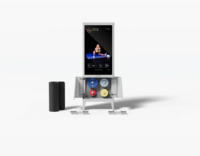For the LGBTQ+ community, there are various family-building options to consider. In honor of Pride Month, we wanted to shine a light on Reciprocal IVF, a beautiful path to parenthood, also known as Co-IVF. Reciprocal IVF is a treatment option for many LGBTQ+ couples in which both partners have eggs and a uterus, such as lesbian or trans couples. What is so incredible about this family-building choice is that it allows each partner to have an intimate role in the creation and growth of the couple’s child.
How does reciprocal IVF work?
During reciprocal IVF, one partner has their eggs retrieved and fertilized with donor sperm. Those embryos are then implanted into the other partner’s uterus. This process allows both partners to be involved in the biological development of the baby.

The mature eggs are then retrieved with a needle guided by an ultrasound. This mildly invasive procedure is done under IV sedation. The harvested eggs are then fertilized with sperm from a donor, and, hopefully, this will result in some healthy, viable embryos.
During reciprocal IVF, while one partner is preparing for an egg retrieval the other is preparing for an embryo transfer. “The carrier undergoes a cycle where they prepare their uterus for the embryo transfer by taking mostly estrogen for several weeks to thicken up the endometrial lining followed by progesterone before having the transfer done,” says Dr. Susan Sarajari, MD, Ph.D., a fertility doctor at Dominion Fertility in Arlington, VA.
Fresh vs. frozen embryos in reciprocal IVF
When reciprocal IVF patients and their physicians are deciding whether to use a fresh or frozen embryo for transfer, there are a few factors to consider. A fresh transfer requires more synchronicity between the two intended parents, while a frozen transfer requires a few additional steps to be taken.
“Fresh embryo transfers require the menstrual cycles of both partners to be synced with each other, which is typically done with birth control pills, “says Dr. Sarajari. “Because once we have the embryos, the other partner’s endometrial lining inside the uterus needs to be ready to have that transfer done. So, there is that component where the cycles have to be synced in order to use a fresh embryo.” In other words, the timeline is tight and strictly overseen for a successful transfer.

“Some people choose to do a frozen transfer because they want to have the embryos tested through PGT, where the embryo’s chromosomes are checked before the transfer, “Dr. Sarajari explains. “If that’s done, then the embryos need to be frozen because it takes a while to get the results back from those tests. Couples might also choose a frozen embryo transfer for convenience. For example, patients might have a tight schedule and be unable to do a transfer within a certain time frame, so they might choose to freeze the embryos until they are ready. The other time we do a frozen versus fresh transfer is if, for example, the couple has done the reciprocal IVF with a fresh transfer and it failed. Then we usually go to a frozen transfer.”
PGT technology can help improve the odds of a successful IVF treatment. These success rates, however, are more so for couples with fertility issues and not necessarily those seeking out reciprocal IVF specifically. According to Dr. Sarajari, “Fresh and frozen transfers in that kind of setting with reciprocal IVF are similarly successful.” So if you, your partner, and your doctor choose to go the fresh or frozen route, the odds of success are high!
In reciprocal IVF, who should provide eggs, and who should carry them?
Going into reciprocal IVF, you and your partner might already know how you want to share the responsibilities of making your baby. You might even plan to take turns if you want more than one child. Remaining flexible, however, is really important during the family planning process, and reciprocal IVF is no exception. You just never know what will be the best option for your success rate.
“When couples first come in, both partners undergo complete fertility testing. We check their ovarian reserve—their quality and quantity of eggs—and then we also check their uterus and its ability to carry a pregnancy,” Dr. Sarajari explains. “Depending on those results, we usually recommend the person with the ovarian reserve of healthier eggs to be the egg provider and the one with the healthier uterus—no fibroids, no polyps or other uterine issues—to be the carrier. Even if patients come in with their minds made up on who they want to provide eggs and be the carrier, we still run the tests and advise them as best as possible.”
The decision might also come down to age. The success rate of IVF is heavily based on the age of the individual providing the eggs. For instance, if providing eggs, those younger than 35 years of age typically have better success rates. After 35, the number and health of your eggs begin to decline, affecting the health of a potential embryo.
Is reciprocal IVF right for you and your partner?
Reciprocal IVF is a wonderful opportunity for many LGBTQ+ couples to both be deeply and personally connected to the creation and growth of their child.
“It is super important to all our patients and the LGBTQ+ community to keep all these options—standard IVF, reciprocal IVF, IUI, etc—open and accessible. And we, at Dominion Fertility, beautifully based right here near Washington D.C., go down to the Capitol each year to talk to the senators and our representatives to make sure that the laws to protect fertility care for all families are preserved and passed. We actively lobby for our patients,” says Dr. Sarajari of her work outside of the clinic.
If you and your partner are considering starting a family and you both want to be involved, speak with your doctor about your options. Reciprocal IVF might just turn out to be the best one for you!
Brighid Flynn is a freelance writer based in Philadelphia where she lives with her husband and puppy. She is just beginning her journey toward motherhood.





.jpeg)








.webp)

.png)












